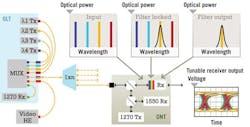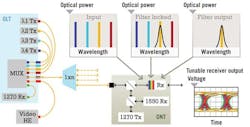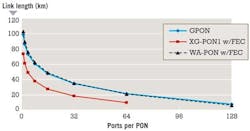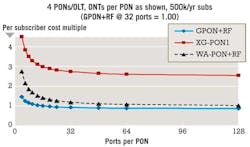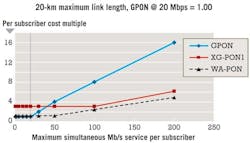By Rob Murano
Next-generation PON systems using four downstream 2.5-Gbps channels and tunable receivers offer significant cost and reach benefits over systems based on single-wavelength 10-Gbps links.
While current FTTH GPON deployments are projected to meet bandwidth demand for a number of years, carriers are already undertaking lab and field trials of XG-PON1 (10 Gbps downstream, 2.5 Gbps upstream). Without bandwidth demand as a driver for adoption, it is clear that as with the move from BPON to GPON, mass deployments of XG-PON1 will commence only when the cost per subscriber is very nearly equal to that of GPON. Implicit in the metric of cost per subscriber is the interplay between system cost and the link budget that can be supported.
Current GPON per-subscriber deployment costs have set a tremendously challenging benchmark through years of manufacturing improvements, price pressure, and a highly competitive GPON components market. With the leading candidates for next-generation systems using a serial bit rate of 10 Gbps, both cost and reach are adversely affected.
An alternative approach, mirroring that observed in transport networks in the 1990s, is a move to multi-wavelength 2.5-Gbps systems. However, unlike transport networks, the colorless nature of PON optical distribution networks (ODNs) and the need for backward-compatibility require that wavelength selectivity be located at the ONT in any WDM scenario designed for coexistence. Static wavelength filtering can be used to accomplish this (“colored ONTs”), but this imposes a significant operational burden on carriers.
For only a small cost premium over a traditional GPON receiver, an optical tunable thin-film bandpass filter can be incorporated into the receiver TO-can to create a “tunable receiver.” These filters allow the receiver, whether PIN- or APD-based, to exist on an ODN with multiple independently modulated channels spaced as finely as 50 GHz apart within an addressable channel window that is typically 5- to 6-nm wide. Such a system is referred to as Wavelength-Agile (WA-) PON, and though not yet formalized by standards organizations, the cost and reach considerations for this approach are compelling.
WA-PON details
An example of a WA-PON system is shown in Figure 1. The 5- to 6-nm WA-PON addressable channel window fits neatly into the XG-PON1 channel range expected to be standardized by the ITU-T as 1575 to 1580 or 1581 nm. The tunable optical bandpass filter in the receiver allows only one of the WDM channels to reach the detector at a time, and can tune from any one channel to any other channel in less than a second. With this wavelength span, and a goal of a 4X downstream bandwidth upgrade as a starting point, WA-PON systems are targeted to initially operate with four 2.5-Gbps channels on a 100- or 200-GHz ITU grid.
This 4x2.5-Gbps WA-PON approach benefits from the cost and reach advantages of GPON, while providing the same aggregate bandwidth as serial 10-Gbps-based approaches. Distinct from systems using static wavelength filtering in the ODN (“colored fiber”) or the colored ONTs, network agility in a WA-PON comes from the use of a low-cost tunable receiver at each ONT. These receivers make possible remote dynamic channel assignment for managing subscribers and bandwidth in the PON and enable the addition of new downstream WA-PON channels at the OLT on an as-needed basis.
Commercially available tunable receivers for WA-PON have been demonstrated in operation in modified GPON ONTs and are now being integrated into diplexer and triplexer optical subassemblies (OSAs). OSA design is straightforward, as the tunable filters are small enough to be packaged with the optics and electronics of a GPON receiver in a single, industry-standard TO46 package.
Coexistence with GPON
GPON systems are being deployed under the ITU-T 984.5 standard, which allows for coexistence with signals in the XG-PON1 band on the same ODN. While the addressable channel window of the tunable receivers can be located anywhere from ~1250 to ~1620 nm, use of the XG-PON1 band has made coexistence with GPON possible. In fact, coexistent system operation on a GPON ODN has been successfully demonstrated for WA-PON.
One consideration for future PON deployments is whether there will be a need to support an RF overlay for broadcast video. The most widely known use of this approach is Verizon’s FiOS service in the USA. With a switch to all IP-based video service unlikely in the next 3–5 years, it is expected that deployments will need to continue to support an RF video overlay.
WA-PON is assumed to incorporate an RF overlay for purposes of cost modeling due to the advantage of the short time-to-market possible for the technology. However, since XG-PON1 systems are not likely to be economically viable in this 3–5 year timeframe, the analysis that follows assumes no support for a video overlay, thus reducing system cost.
Reach
Increasing the serial bit rate in a PON system from 2.5 Gbps to 10 Gbps results in a link budget penalty of at least 6 dB due to reduced receiver sensitivity. Furthermore, the increased bit rate results in a significant amount of chromatic dispersion-induced path penalty. There are plans to implement higher sensitivity electronics, forward error correction (FEC), and higher launch powers with XG-PON1 systems to help overcome these deficits and achieve the link budgets currently under consideration for XG-PON1 standardization as Nominal Class I (29dB) and Nominal Class II (31dB). However, any approach used to realize gains in link budget at 10 Gbps is equally applicable to GPON and 2.5 Gbps WA-PON. WA-PON does have its own reach limitations — primarily the loss incurred by multiplexing the downstream sources at the OLT and the insertion loss of the tunable filter at the ONT (<2.5 dB and <1.5 dB, respectively).
With all system design parameters equal, such as transmitter output power (+5 dBm), noise levels in the receiver, fiber dispersion, and FEC gain (4 dB), the link budget can be calculated for each type of PON system. The interplay between maximum link length and number of PON subscribers can then be determined, and the resulting possible combinations compared with a standard GPON system as shown in Figure 2. Adding FEC to GPON can also achieve greater reach or splits, but downstream aggregate bandwidth will remain limited to 2.5 Gbps.
The addition of FEC in the WA-PON system overcomes the losses from the optical multiplexer at the OLT and the filter at the ONT. When combined with the lower attenuation per kilometer at 1575 nm versus 1490 nm, WA-PON reach actually exceeds that GPON. This analysis does not consider the limitations of upstream transmission, which for WA-PON will be identical to either GPON if at 1.25 Gbps or XG-PON1 if at 2.5 Gbps. The RF link budget was also not considered for this analysis.
Cost
The economics of next-generation deployments are more sensitive to cost at the ONT than the OLT due to amortization of OLT cost over the number of subscribers each PON serves. To this end, 2.5-Gbps WA-PON systems use standard GPON receiver electronics, with only an additional current drive circuit costing less than $1 required in each ONT. This low cost delta is achieved by using the microcontroller already located on a GPON ONT board that controls the laser diode and avalanche photodiode bias to run the simple tuning and locking algorithms required to control the tunable filter.
The tunable thin-film filter itself is manufactured on wafers using standard semiconductor processes and equipment, and can be both optically and electrically probed at wafer level prior to dicing and picking to ensure operational efficiency. This wafer-level manufacturing and automated early process screening are easily scalable at low costs to support the volumes needed for mass deployment.
The greatest increase in cost for both XG-PON1 and WA-PON are seen in the optics, but as noted, the ONT has a much larger per-subscriber cost impact. This is most significant at 10 Gbps, due to the high bit rate receiver, while in WA-PON, the OLT carries the vast majority of the increase due to the additional transmitters and multiplexing optics.
Combining the supported link length and port count with cost information from a broad survey of market reports, chip vendors, and component manufacturers, a cost multiple relative to standard GPON per subscriber versus port count on a PON can be calculated. Figure 3 shows the result of this calculation.
Even with the generous assumption that the cost of 10-Gbps electronics is identical to those at 2.5 Gbps, there is a substantial cost advantage to a multi-wavelength system at 2.5 Gbps. Additionally, the XG-PON1 calculation does not include an RF overlay, as opposed to GPON and WA-PON, further highlighting the cost-effectiveness of WA-PON.
Service consideration
Cost per subscriber by achievable bit rate also plays a part in making the case for WA-PON as a competitive technology. In Figure 4, a simple calculation of the aggregate downstream bandwidth divided by the number of ports supported on a 20-km span (reference Figure 2) is presented. Due to differences in calculation, the effect of statistical multiplexing gain is not shown here, but the impact would be nearly equal, leaving the relative relationships unchanged.
Given a supported port count of 128 on a GPON link length of 20 km, 20 Mbps approximates the level of peak simultaneous service supported, and is used as a cost reference point. Of course, with substantial oversubscription rates common and PONs typically populated with much lower port counts, the capacity of current GPON outstrips demand for the near future. However, as the per-port bandwidth is increased, the cost of GPON rises (since fewer ports can be supported at the higher service level) and quickly becomes more expensive than WA-PON, which maintains a significant cost advantage over XG-PON1 regardless of service level.
Future-proof infrastructure
Considerations for next-generation PON deployments must also include what comes next. In the case of WA-PON, each ONT is outfitted with a narrow bandpass filter, meaning coexistence with wavelengths added in the future is assured. Meanwhile, the tunable nature of the filter makes it possible to add channels beyond the initial four, growing aggregate bandwidth beyond that supported by XG-PON1.
Additionally, when a tunable receiver operating at serial 10 Gbps is justifiable by cost and bandwidth demand, future deployments could mingle 2.5- and 10-Gbps signals to further enhance capacity. All these factors combine to highlight the inherent future-proof nature of WA-PON.
With the reality of the costs for XG-PON1 hitting home, the PON market faces a technologically stagnant period while cost reductions are hammered out of serial 10-Gbps technology. As a near- and mid-term solution, 2.5 Gbps WA-PON is cost and reach competitive with GPON and offers a path to greater than 10-Gbps aggregate bandwidth.
Rob Murano is the program manager for optical component development at Aegis Lightwave.
